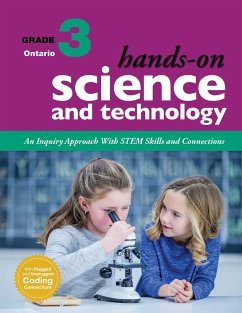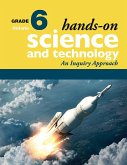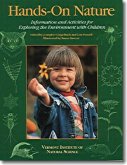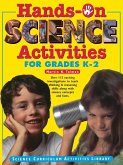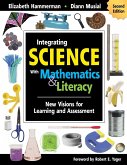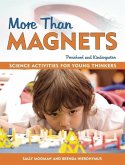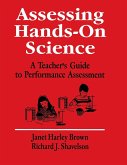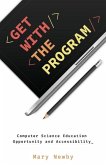Jennifer E. Lawson
Hands-On Science and Technology for Ontario, Grade 3
An Inquiry Approach With STEM Skills and Connections
Jennifer E. Lawson
Hands-On Science and Technology for Ontario, Grade 3
An Inquiry Approach With STEM Skills and Connections
- Broschiertes Buch
- Merkliste
- Auf die Merkliste
- Bewerten Bewerten
- Teilen
- Produkt teilen
- Produkterinnerung
- Produkterinnerung
Teach coding with confidence using lesson plans custom-written for Ontario's science and technology (2022) curriculum. This book provides resources for both teachers and students including background information on the science topics; complete, easy-to-follow lesson plans; materials lists; and digital image banks and reproducibles.
Andere Kunden interessierten sich auch für
![Hands-On Science and Technology for Ontario, Grade 6 Hands-On Science and Technology for Ontario, Grade 6]() Jennifer E LawsonHands-On Science and Technology for Ontario, Grade 6138,99 €
Jennifer E LawsonHands-On Science and Technology for Ontario, Grade 6138,99 €![Hands-On Nature: Information and Activities for Exploring the Environment with Children Hands-On Nature: Information and Activities for Exploring the Environment with Children]() Hands-On Nature: Information and Activities for Exploring the Environment with Children21,99 €
Hands-On Nature: Information and Activities for Exploring the Environment with Children21,99 €![Hands-On Science Activities Grades Hands-On Science Activities Grades]() TolmanHands-On Science Activities Grades32,99 €
TolmanHands-On Science Activities Grades32,99 €![Integrating Science With Mathematics & Literacy Integrating Science With Mathematics & Literacy]() Elizabeth HammermanIntegrating Science With Mathematics & Literacy36,99 €
Elizabeth HammermanIntegrating Science With Mathematics & Literacy36,99 €![More Than Magnets: Exploring the Wonders of Science in Preschool and Kindergarten More Than Magnets: Exploring the Wonders of Science in Preschool and Kindergarten]() Sally MoomawMore Than Magnets: Exploring the Wonders of Science in Preschool and Kindergarten23,99 €
Sally MoomawMore Than Magnets: Exploring the Wonders of Science in Preschool and Kindergarten23,99 €![Assessing Hands-On Science Assessing Hands-On Science]() Janet Harley BrownAssessing Hands-On Science35,99 €
Janet Harley BrownAssessing Hands-On Science35,99 €![Get with the Program: Computer Science Education Opportunity and Accessibility Get with the Program: Computer Science Education Opportunity and Accessibility]() Mary NewbyGet with the Program: Computer Science Education Opportunity and Accessibility12,99 €
Mary NewbyGet with the Program: Computer Science Education Opportunity and Accessibility12,99 €-
-
-
Teach coding with confidence using lesson plans custom-written for Ontario's science and technology (2022) curriculum. This book provides resources for both teachers and students including background information on the science topics; complete, easy-to-follow lesson plans; materials lists; and digital image banks and reproducibles.
Produktdetails
- Produktdetails
- Verlag: Portage & Main Press
- New Edition, Updated & Revised
- Seitenzahl: 360
- Erscheinungstermin: 3. Oktober 2024
- Englisch
- Abmessung: 279mm x 215mm x 38mm
- Gewicht: 943g
- ISBN-13: 9781774920688
- ISBN-10: 1774920689
- Artikelnr.: 68583075
- Herstellerkennzeichnung
- Libri GmbH
- Europaallee 1
- 36244 Bad Hersfeld
- gpsr@libri.de
- Verlag: Portage & Main Press
- New Edition, Updated & Revised
- Seitenzahl: 360
- Erscheinungstermin: 3. Oktober 2024
- Englisch
- Abmessung: 279mm x 215mm x 38mm
- Gewicht: 943g
- ISBN-13: 9781774920688
- ISBN-10: 1774920689
- Artikelnr.: 68583075
- Herstellerkennzeichnung
- Libri GmbH
- Europaallee 1
- 36244 Bad Hersfeld
- gpsr@libri.de
¿¿Jennifer E. Lawson, PhD, is the creator of the Hands-On books published by Portage & Main Press. As senior writer and editor for the series, she has contributed to more than 50 publications for teachers and students. Jennifer provides professional development workshops for educators locally, nationally, and virtually, and is a Workplace Wellness Advisor. Her most recent book is a collective effort called Teacher, Take Care: A Guide to Well-Being and Workplace Wellness for Educators. She is also one of the founders of Mission to Mexico, an organization that supports schools in some of the most impoverished communities in Puerto Vallarta. Throughout her extensive career in education, Jennifer has worked as a classroom teacher, resource and special education teacher, consultant, principal, university instructor, and school trustee. She lives with her family in Winnipeg, Manitoba.
Introduction to Hands-On Science and Technology for Ontario, Grade 3 1
* Introduction to Hands-On Science and Technology 2
* Program Introduction 2
* The Inquiry Approach to Science and Technology 2
* 21st Century Teaching and Learning 3
* The Goals of the Science and Technology Program 3
* Hands-On Science and Technology Strands and Expectations 4
* Hands-On Science and Technology Fundamental Concepts and Big Ideas 4
* Hands-On Science and Technology Program Principles 5
* Infusing Indigenous Perspectives 5
* Cultural Connections 7
* Land-Based Learning 7
* Technology 7
* Sustainability 7
* Program Implementation 8
* Program Resources 8
* Classroom Environment 11
* Planning Units-Timelines 12
* Classroom Management 12
* Classroom Safety 12
* Scientific Inquiry Skills: Guidelines for Teachers 12
* Observing 12
* Questioning 13
* Exploring 13
* Classifying 13
* Measuring 14
* Communicating, Analyzing, and Interpreting 14
* Predicting 15
* Inferring 15
* Inquiry Through Investigating and Experimenting 16
* Inquiry Through Research 16
* Online Considerations 17
* Addressing Students' Early Literacy Needs 17
* Technological Problem Solving 17
* Makerspace 18
The Hands-On Science and Technology Assessment Plan 20
* Assessment for Learning 21
* Assessment as Learning 21
* Assessment of Learning 22
* Performance Assessment 23
* Portfolios 23
* Evidence of Student Achievement Levels for Evaluation 24
* Important Note to Teachers 24
* References 25
* Assessment Reproducibles 26
* Achievement Chart for Science & Technology 41
Unit 1: Growth and Changes in Plants 43
* Introduction 44
* Unit Overview 48
* Curriculum Correlation 49
* Resources for Students 51
* Websites 53
* 1 What Do We Know About Plants and Their Needs? 56
* 2 What Are the Parts of a Plant? 61
* 3 What Are Some Special Features of Plants? 65
* 4 How Do Plants Adapt in Order to Survive? 73
* 5 What Is the Life Cycle of a Plant? 78
* 6 What Parts of Plants Do We Eat? 84
* 7 What Are the Different Ways in Which Plants Are Grown for Food? 89
* 8 How Can We Investigate the Needs of Plants? 94
* 9 How Can We Design a Terrarium to Sustain Living Things? 100
* 10 In What Other Ways Are Plants Important to Humans? 105
* 11 How Can Dye Be Made From Plants? 109
* 12 How Do Plants and Animals Depend on Each Other? 114
* 13 How Do Plants Help Reduce Erosion? 118
* 14 How Can We Protect Plants? 122
* 15 Inquiry Project: What More Can I Learn About Plant Products? 126
Unit 2: Strong and Stable Structures 129
* Introduction 130
* Unit Overview 133
* Curriculum Correlation 134
* Resources for Students 135
* Websites and Online Videos 136
* 1 What Is a Structure? 138
* 2 Where Are Structures Found? 143
* 3 Which Materials Are Stronger Than Others? 147
* 4 What Are Joints? 154
* 5 How Can We Build Structures to Be Stronger and More Stable? 160
* 6 How Can We Build a Frame That Is Strong and Stable? 165
* 7 What Structures Has Nature Engineered? 170
* 8 How Are Structures Around the World Similar and Different? 176
* 9 What Are Some Careers in Design and Building? 181
* 10 What Other Structures Can We Build? 185
* 11 Inquiry Project: What More Can I Learn About Important Buildings
and Structures? 192
Unit 3: Forces Causing Movement 195
* Introduction 196
* Unit Overview 199
* Curriculum Correlation 200
* Resources for Students 201
* Websites and Online Videos 203
* 1 What Is a Force? 206
* 2 How Is a Force a Push or a Pull? 210
* 3 What Is Friction? 214
* 4 Which Objects Do Magnets Attract? 217
* 5 How Is a Magnet Made? 222
* 6 How Can a Magnetic Force Be Altered? 226
* 7 How Is Earth Like a Giant Magnet? 232
* 8 What Are Helpful Uses and Harmful Effects of Magnets? 237
* 9 What Is Static Electricity, and How Is It Created? 240
* 10 How Does Humidity Affect Static Electricity? 244
* 11 How Can the Force of Static Electricity Be Demonstrated Safely?
248
* 12 How Does an Electroscope Work? 252
* 13 What Effect Does Gravity Have on Different Objects? 255
* 14 What Are Some Forces of Nature? 262
* 15 How Are Forces Used to Move Toys? 266
* 16 How Can Safety Devices Be Used to Reduce the Effects of Forces?
270
* 17 Inquiry Project: How Can I Design a Toy or Game That Uses Forces?
273
Unit 4: Soils in the Environment 277
* Introduction 278
* Unit Overview 281
* Curriculum Correlation 282
* Resources for Students 283
* Websites and Online Videos 285
* 1 What Do We Know About Soil? 287
* 2 What Are the Different Types of Soil? 291
* 3 How Can Soil Components Be Separated? 297
* 4 How Much Water Can Different Soil Types Absorb? 301
* 5 How Do Different Soils Affect the Growth of Plants? 306
* 6 What Lives in Soil? 312
* 7 How Does Rainfall Affect Soil? 316
* 8 How Can Organic Materials Be Recycled? 320
* 9 How Do Humans Use Earth Materials? 325
* 10 Inquiry Project: What More Can We Learn About Products Made From
Earth Materials? 328
* References 333
Appendix: Image Banks 335
About the Contributors 353
* Introduction to Hands-On Science and Technology 2
* Program Introduction 2
* The Inquiry Approach to Science and Technology 2
* 21st Century Teaching and Learning 3
* The Goals of the Science and Technology Program 3
* Hands-On Science and Technology Strands and Expectations 4
* Hands-On Science and Technology Fundamental Concepts and Big Ideas 4
* Hands-On Science and Technology Program Principles 5
* Infusing Indigenous Perspectives 5
* Cultural Connections 7
* Land-Based Learning 7
* Technology 7
* Sustainability 7
* Program Implementation 8
* Program Resources 8
* Classroom Environment 11
* Planning Units-Timelines 12
* Classroom Management 12
* Classroom Safety 12
* Scientific Inquiry Skills: Guidelines for Teachers 12
* Observing 12
* Questioning 13
* Exploring 13
* Classifying 13
* Measuring 14
* Communicating, Analyzing, and Interpreting 14
* Predicting 15
* Inferring 15
* Inquiry Through Investigating and Experimenting 16
* Inquiry Through Research 16
* Online Considerations 17
* Addressing Students' Early Literacy Needs 17
* Technological Problem Solving 17
* Makerspace 18
The Hands-On Science and Technology Assessment Plan 20
* Assessment for Learning 21
* Assessment as Learning 21
* Assessment of Learning 22
* Performance Assessment 23
* Portfolios 23
* Evidence of Student Achievement Levels for Evaluation 24
* Important Note to Teachers 24
* References 25
* Assessment Reproducibles 26
* Achievement Chart for Science & Technology 41
Unit 1: Growth and Changes in Plants 43
* Introduction 44
* Unit Overview 48
* Curriculum Correlation 49
* Resources for Students 51
* Websites 53
* 1 What Do We Know About Plants and Their Needs? 56
* 2 What Are the Parts of a Plant? 61
* 3 What Are Some Special Features of Plants? 65
* 4 How Do Plants Adapt in Order to Survive? 73
* 5 What Is the Life Cycle of a Plant? 78
* 6 What Parts of Plants Do We Eat? 84
* 7 What Are the Different Ways in Which Plants Are Grown for Food? 89
* 8 How Can We Investigate the Needs of Plants? 94
* 9 How Can We Design a Terrarium to Sustain Living Things? 100
* 10 In What Other Ways Are Plants Important to Humans? 105
* 11 How Can Dye Be Made From Plants? 109
* 12 How Do Plants and Animals Depend on Each Other? 114
* 13 How Do Plants Help Reduce Erosion? 118
* 14 How Can We Protect Plants? 122
* 15 Inquiry Project: What More Can I Learn About Plant Products? 126
Unit 2: Strong and Stable Structures 129
* Introduction 130
* Unit Overview 133
* Curriculum Correlation 134
* Resources for Students 135
* Websites and Online Videos 136
* 1 What Is a Structure? 138
* 2 Where Are Structures Found? 143
* 3 Which Materials Are Stronger Than Others? 147
* 4 What Are Joints? 154
* 5 How Can We Build Structures to Be Stronger and More Stable? 160
* 6 How Can We Build a Frame That Is Strong and Stable? 165
* 7 What Structures Has Nature Engineered? 170
* 8 How Are Structures Around the World Similar and Different? 176
* 9 What Are Some Careers in Design and Building? 181
* 10 What Other Structures Can We Build? 185
* 11 Inquiry Project: What More Can I Learn About Important Buildings
and Structures? 192
Unit 3: Forces Causing Movement 195
* Introduction 196
* Unit Overview 199
* Curriculum Correlation 200
* Resources for Students 201
* Websites and Online Videos 203
* 1 What Is a Force? 206
* 2 How Is a Force a Push or a Pull? 210
* 3 What Is Friction? 214
* 4 Which Objects Do Magnets Attract? 217
* 5 How Is a Magnet Made? 222
* 6 How Can a Magnetic Force Be Altered? 226
* 7 How Is Earth Like a Giant Magnet? 232
* 8 What Are Helpful Uses and Harmful Effects of Magnets? 237
* 9 What Is Static Electricity, and How Is It Created? 240
* 10 How Does Humidity Affect Static Electricity? 244
* 11 How Can the Force of Static Electricity Be Demonstrated Safely?
248
* 12 How Does an Electroscope Work? 252
* 13 What Effect Does Gravity Have on Different Objects? 255
* 14 What Are Some Forces of Nature? 262
* 15 How Are Forces Used to Move Toys? 266
* 16 How Can Safety Devices Be Used to Reduce the Effects of Forces?
270
* 17 Inquiry Project: How Can I Design a Toy or Game That Uses Forces?
273
Unit 4: Soils in the Environment 277
* Introduction 278
* Unit Overview 281
* Curriculum Correlation 282
* Resources for Students 283
* Websites and Online Videos 285
* 1 What Do We Know About Soil? 287
* 2 What Are the Different Types of Soil? 291
* 3 How Can Soil Components Be Separated? 297
* 4 How Much Water Can Different Soil Types Absorb? 301
* 5 How Do Different Soils Affect the Growth of Plants? 306
* 6 What Lives in Soil? 312
* 7 How Does Rainfall Affect Soil? 316
* 8 How Can Organic Materials Be Recycled? 320
* 9 How Do Humans Use Earth Materials? 325
* 10 Inquiry Project: What More Can We Learn About Products Made From
Earth Materials? 328
* References 333
Appendix: Image Banks 335
About the Contributors 353
Introduction to Hands-On Science and Technology for Ontario, Grade 3 1
* Introduction to Hands-On Science and Technology 2
* Program Introduction 2
* The Inquiry Approach to Science and Technology 2
* 21st Century Teaching and Learning 3
* The Goals of the Science and Technology Program 3
* Hands-On Science and Technology Strands and Expectations 4
* Hands-On Science and Technology Fundamental Concepts and Big Ideas 4
* Hands-On Science and Technology Program Principles 5
* Infusing Indigenous Perspectives 5
* Cultural Connections 7
* Land-Based Learning 7
* Technology 7
* Sustainability 7
* Program Implementation 8
* Program Resources 8
* Classroom Environment 11
* Planning Units-Timelines 12
* Classroom Management 12
* Classroom Safety 12
* Scientific Inquiry Skills: Guidelines for Teachers 12
* Observing 12
* Questioning 13
* Exploring 13
* Classifying 13
* Measuring 14
* Communicating, Analyzing, and Interpreting 14
* Predicting 15
* Inferring 15
* Inquiry Through Investigating and Experimenting 16
* Inquiry Through Research 16
* Online Considerations 17
* Addressing Students' Early Literacy Needs 17
* Technological Problem Solving 17
* Makerspace 18
The Hands-On Science and Technology Assessment Plan 20
* Assessment for Learning 21
* Assessment as Learning 21
* Assessment of Learning 22
* Performance Assessment 23
* Portfolios 23
* Evidence of Student Achievement Levels for Evaluation 24
* Important Note to Teachers 24
* References 25
* Assessment Reproducibles 26
* Achievement Chart for Science & Technology 41
Unit 1: Growth and Changes in Plants 43
* Introduction 44
* Unit Overview 48
* Curriculum Correlation 49
* Resources for Students 51
* Websites 53
* 1 What Do We Know About Plants and Their Needs? 56
* 2 What Are the Parts of a Plant? 61
* 3 What Are Some Special Features of Plants? 65
* 4 How Do Plants Adapt in Order to Survive? 73
* 5 What Is the Life Cycle of a Plant? 78
* 6 What Parts of Plants Do We Eat? 84
* 7 What Are the Different Ways in Which Plants Are Grown for Food? 89
* 8 How Can We Investigate the Needs of Plants? 94
* 9 How Can We Design a Terrarium to Sustain Living Things? 100
* 10 In What Other Ways Are Plants Important to Humans? 105
* 11 How Can Dye Be Made From Plants? 109
* 12 How Do Plants and Animals Depend on Each Other? 114
* 13 How Do Plants Help Reduce Erosion? 118
* 14 How Can We Protect Plants? 122
* 15 Inquiry Project: What More Can I Learn About Plant Products? 126
Unit 2: Strong and Stable Structures 129
* Introduction 130
* Unit Overview 133
* Curriculum Correlation 134
* Resources for Students 135
* Websites and Online Videos 136
* 1 What Is a Structure? 138
* 2 Where Are Structures Found? 143
* 3 Which Materials Are Stronger Than Others? 147
* 4 What Are Joints? 154
* 5 How Can We Build Structures to Be Stronger and More Stable? 160
* 6 How Can We Build a Frame That Is Strong and Stable? 165
* 7 What Structures Has Nature Engineered? 170
* 8 How Are Structures Around the World Similar and Different? 176
* 9 What Are Some Careers in Design and Building? 181
* 10 What Other Structures Can We Build? 185
* 11 Inquiry Project: What More Can I Learn About Important Buildings
and Structures? 192
Unit 3: Forces Causing Movement 195
* Introduction 196
* Unit Overview 199
* Curriculum Correlation 200
* Resources for Students 201
* Websites and Online Videos 203
* 1 What Is a Force? 206
* 2 How Is a Force a Push or a Pull? 210
* 3 What Is Friction? 214
* 4 Which Objects Do Magnets Attract? 217
* 5 How Is a Magnet Made? 222
* 6 How Can a Magnetic Force Be Altered? 226
* 7 How Is Earth Like a Giant Magnet? 232
* 8 What Are Helpful Uses and Harmful Effects of Magnets? 237
* 9 What Is Static Electricity, and How Is It Created? 240
* 10 How Does Humidity Affect Static Electricity? 244
* 11 How Can the Force of Static Electricity Be Demonstrated Safely?
248
* 12 How Does an Electroscope Work? 252
* 13 What Effect Does Gravity Have on Different Objects? 255
* 14 What Are Some Forces of Nature? 262
* 15 How Are Forces Used to Move Toys? 266
* 16 How Can Safety Devices Be Used to Reduce the Effects of Forces?
270
* 17 Inquiry Project: How Can I Design a Toy or Game That Uses Forces?
273
Unit 4: Soils in the Environment 277
* Introduction 278
* Unit Overview 281
* Curriculum Correlation 282
* Resources for Students 283
* Websites and Online Videos 285
* 1 What Do We Know About Soil? 287
* 2 What Are the Different Types of Soil? 291
* 3 How Can Soil Components Be Separated? 297
* 4 How Much Water Can Different Soil Types Absorb? 301
* 5 How Do Different Soils Affect the Growth of Plants? 306
* 6 What Lives in Soil? 312
* 7 How Does Rainfall Affect Soil? 316
* 8 How Can Organic Materials Be Recycled? 320
* 9 How Do Humans Use Earth Materials? 325
* 10 Inquiry Project: What More Can We Learn About Products Made From
Earth Materials? 328
* References 333
Appendix: Image Banks 335
About the Contributors 353
* Introduction to Hands-On Science and Technology 2
* Program Introduction 2
* The Inquiry Approach to Science and Technology 2
* 21st Century Teaching and Learning 3
* The Goals of the Science and Technology Program 3
* Hands-On Science and Technology Strands and Expectations 4
* Hands-On Science and Technology Fundamental Concepts and Big Ideas 4
* Hands-On Science and Technology Program Principles 5
* Infusing Indigenous Perspectives 5
* Cultural Connections 7
* Land-Based Learning 7
* Technology 7
* Sustainability 7
* Program Implementation 8
* Program Resources 8
* Classroom Environment 11
* Planning Units-Timelines 12
* Classroom Management 12
* Classroom Safety 12
* Scientific Inquiry Skills: Guidelines for Teachers 12
* Observing 12
* Questioning 13
* Exploring 13
* Classifying 13
* Measuring 14
* Communicating, Analyzing, and Interpreting 14
* Predicting 15
* Inferring 15
* Inquiry Through Investigating and Experimenting 16
* Inquiry Through Research 16
* Online Considerations 17
* Addressing Students' Early Literacy Needs 17
* Technological Problem Solving 17
* Makerspace 18
The Hands-On Science and Technology Assessment Plan 20
* Assessment for Learning 21
* Assessment as Learning 21
* Assessment of Learning 22
* Performance Assessment 23
* Portfolios 23
* Evidence of Student Achievement Levels for Evaluation 24
* Important Note to Teachers 24
* References 25
* Assessment Reproducibles 26
* Achievement Chart for Science & Technology 41
Unit 1: Growth and Changes in Plants 43
* Introduction 44
* Unit Overview 48
* Curriculum Correlation 49
* Resources for Students 51
* Websites 53
* 1 What Do We Know About Plants and Their Needs? 56
* 2 What Are the Parts of a Plant? 61
* 3 What Are Some Special Features of Plants? 65
* 4 How Do Plants Adapt in Order to Survive? 73
* 5 What Is the Life Cycle of a Plant? 78
* 6 What Parts of Plants Do We Eat? 84
* 7 What Are the Different Ways in Which Plants Are Grown for Food? 89
* 8 How Can We Investigate the Needs of Plants? 94
* 9 How Can We Design a Terrarium to Sustain Living Things? 100
* 10 In What Other Ways Are Plants Important to Humans? 105
* 11 How Can Dye Be Made From Plants? 109
* 12 How Do Plants and Animals Depend on Each Other? 114
* 13 How Do Plants Help Reduce Erosion? 118
* 14 How Can We Protect Plants? 122
* 15 Inquiry Project: What More Can I Learn About Plant Products? 126
Unit 2: Strong and Stable Structures 129
* Introduction 130
* Unit Overview 133
* Curriculum Correlation 134
* Resources for Students 135
* Websites and Online Videos 136
* 1 What Is a Structure? 138
* 2 Where Are Structures Found? 143
* 3 Which Materials Are Stronger Than Others? 147
* 4 What Are Joints? 154
* 5 How Can We Build Structures to Be Stronger and More Stable? 160
* 6 How Can We Build a Frame That Is Strong and Stable? 165
* 7 What Structures Has Nature Engineered? 170
* 8 How Are Structures Around the World Similar and Different? 176
* 9 What Are Some Careers in Design and Building? 181
* 10 What Other Structures Can We Build? 185
* 11 Inquiry Project: What More Can I Learn About Important Buildings
and Structures? 192
Unit 3: Forces Causing Movement 195
* Introduction 196
* Unit Overview 199
* Curriculum Correlation 200
* Resources for Students 201
* Websites and Online Videos 203
* 1 What Is a Force? 206
* 2 How Is a Force a Push or a Pull? 210
* 3 What Is Friction? 214
* 4 Which Objects Do Magnets Attract? 217
* 5 How Is a Magnet Made? 222
* 6 How Can a Magnetic Force Be Altered? 226
* 7 How Is Earth Like a Giant Magnet? 232
* 8 What Are Helpful Uses and Harmful Effects of Magnets? 237
* 9 What Is Static Electricity, and How Is It Created? 240
* 10 How Does Humidity Affect Static Electricity? 244
* 11 How Can the Force of Static Electricity Be Demonstrated Safely?
248
* 12 How Does an Electroscope Work? 252
* 13 What Effect Does Gravity Have on Different Objects? 255
* 14 What Are Some Forces of Nature? 262
* 15 How Are Forces Used to Move Toys? 266
* 16 How Can Safety Devices Be Used to Reduce the Effects of Forces?
270
* 17 Inquiry Project: How Can I Design a Toy or Game That Uses Forces?
273
Unit 4: Soils in the Environment 277
* Introduction 278
* Unit Overview 281
* Curriculum Correlation 282
* Resources for Students 283
* Websites and Online Videos 285
* 1 What Do We Know About Soil? 287
* 2 What Are the Different Types of Soil? 291
* 3 How Can Soil Components Be Separated? 297
* 4 How Much Water Can Different Soil Types Absorb? 301
* 5 How Do Different Soils Affect the Growth of Plants? 306
* 6 What Lives in Soil? 312
* 7 How Does Rainfall Affect Soil? 316
* 8 How Can Organic Materials Be Recycled? 320
* 9 How Do Humans Use Earth Materials? 325
* 10 Inquiry Project: What More Can We Learn About Products Made From
Earth Materials? 328
* References 333
Appendix: Image Banks 335
About the Contributors 353

